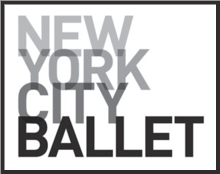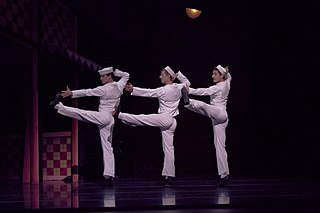Related Research Articles

New York City Ballet (NYCB) is a ballet company founded in 1948 by choreographer George Balanchine and Lincoln Kirstein. Balanchine and Jerome Robbins are considered the founding choreographers of the company. Léon Barzin was the company's first music director. City Ballet grew out of earlier troupes: the Producing Company of the School of American Ballet, 1934; the American Ballet, 1935, and Ballet Caravan, 1936, which merged into American Ballet Caravan, 1941; and directly from the Ballet Society, 1946.
The Ice Theatre of New York is a professional ensemble company dancing on ice, performing works by choreographers drawn from competitive figure skating and modern and contemporary dance. Aiming to create dance on ice as part of the modern performing arts scene, Ice Theatre of New York (ITNY) was first conceived by Marc Bogaerts, Marjorie Kouns, Cecily Morrow and Moira North. Moira North went on to found ITNY in 1984. North, a Canadian-born skater was twice named one of the 25 most influential names in figure skating by International Figure Skating Magazine. Based at the Chelsea Piers rink complex in New York City, Ice Theatre of New York was the first not-for-profit professional ice dance company in the U.S. and the first to receive funding from the National Endowment for the Arts, New York State Council on the Arts, and New York City Department of Cultural Affairs. Italian ice dancer, choreographer and aerialist, Elisa Angeli, is Ice Theatre of New York’s Ensemble Director.
Jewels is a three-act ballet created for the New York City Ballet by co-founder and founding choreographer George Balanchine. It premièred on Thursday, 13 April 1967 at the New York State Theater, with sets designed by Peter Harvey and lighting by Ronald Bates.
Thou Swell is a ballet created by New York City Ballet's balletmaster-in-chief Peter Martins to the songs of Richard Rodgers in an arrangement by Glen Kelly with orchestrations Don Sebesky.
Sean Lavery was a former principal dancer, balletmaster, and assistant to the balletmaster in chief at New York City Ballet. He was a répétiteur for the George Balanchine Trust and a former faculty member at the School of American Ballet.
Zakouski is a ballet made by New York City Ballet ballet master in chief Peter Martins to:
Oltremare is a ballet by Mauro Bigonzetti to Bruno Moretti's eponymous music commissioned by New York City Ballet. The premiere took place Wednesday, January 23, 2008, at the New York State Theater, Lincoln Center, with costumes by the choreographer and Marc Happel and lighting by Mark Stanley. Oltremare is the third of three Bigonzetti / Moretti ballets commissioned by City Ballet, the others being Vespro and In Vento.
Valse Triste is a ballet choreographed by Peter Martins when he was balletmaster at the New York City Ballet to Sibelius's eponymous waltz as well as the music called Scene with Cranes from his incidental music for the play Kuolema (Death). The crane is a symbol of death in Finnish literature. The premiere took place on May 23, 1985, at the New York State Theater, Lincoln Center, with original lighting by Ronald Bates and current lighting by Mark Stanley.
West Side Story Suite is a ballet made by New York City Ballet balletmaster Jerome Robbins to the 1957 music by Leonard Bernstein and lyrics of Stephen Sondheim and extracted from the eponymous musical which he had choreographed, with scenery by Oliver Smith, costumes by Irene Sharaff and lighting by Jennifer Tipton. The premiere took place at New York State Theater on Thursday, May 18, 1995. Nikolaj Hübbe and Jock Soto, both members of the original cast, as well as Peter Boal all chose to include West Side Story Suite in their farewell performances at City Ballet.
Symphony in Three Movements is a ballet made by New York City Ballet co-founder and balletmaster George Balanchine for the opening night of the New York City Ballet Stravinsky Festival, based on Igor Stravinsky's 1942–45 Symphony in Three Movements, with lighting by Mark Stanley. The premiere took place on June 18, 1972, at the New York State Theater, Lincoln Center for the Performing Arts.

Fancy Free is a ballet by Jerome Robbins, subsequently ballet master of New York City Ballet, made on Ballet Theatre, predecessor of American Ballet Theatre, to a score by Leonard Bernstein, with scenery by Oliver Smith, costumes by Kermit Love and lighting by Ronald Bates. The premiere took place on Tuesday, 18 April 1944 at the old Metropolitan Opera House, New York. The NYCB premiere took place Thursday, 31 January 1980. Fancy Free was the inspiration for a successful musical, On the Town, and a portion of the score was also used in the opening scenes of Alfred Hitchcock's Rear Window.
Andantino, originally titled Pas de Deux, is a ballet made for New York City Ballet's Tschaikovsky Festival by ballet master Jerome Robbins to the second movement of the composer's Piano Concerto No. 1 in B flat minor, Op. 23 (1875). The premiere took place on 4 June 1981 at New York State Theater, Lincoln Center, with costumes by Ben Benson and lighting by Ronald Bates.
Piano Pieces is a ballet made for New York City Ballet's Tschaikovsky Festival by ballet master Jerome Robbins to Tchaikovsky's music. The premiere took place on 11 June 1981 at the New York State Theater, Lincoln Center, with costumes by Ben Benson and lighting by Ronald Bates.
The Chairman Dances is a ballet made by New York City Ballet ballet master in chief Peter Martins to John Adams' eponymous music from 1985. The music was originally written for Adams' opera, Nixon in China, but not used in production: the scene is that in which Mao Zedong dances with his future bride, movie star Chiang Ch'ing. The premiere took place on 14 May 1988, as part of City Ballet's American Music Festival at New York State Theater, Lincoln Center, with scenery and costumes by Rouben Ter-Arutunian, and lighting by Mark Stanley.
La Sonnambula(The Sleepwalker) is a ballet by the co-founder and ballet master of New York City Ballet, George Balanchine, made to Vittorio Rieti's music using themes from the operas of Vincenzo Bellini including La Sonnambula, Norma, I Puritani and I Capuleti e i Montecchi (1830–35).
Ives, Songs is a ballet made by New York City Ballet ballet master Jerome Robbins to songs of Charles Ives:
Tschaikovsky Piano Concerto No. 2, originally called Ballet Imperial, is a ballet in three movements made by New York City Ballet's co-founder and founding choreographer George Balanchine for his earlier company, American Ballet Caravan, to the version of Peter Ilyitch Tchaikovsky's Piano Concerto No. 2, originally composed in 1879–80, but later revised by Alexander Siloti. The ballet was given a preview performance on 29 May 1941 at the Little Theater of Hunter College in New York City. The premiere took place on 25 June 1941 at Teatro Municipal, Rio de Janeiro.
The Prodigal Son, or Le Fils prodigue, Op. 46 is a ballet created for Diaghilev's Ballets Russes by George Balanchine to music by Sergei Prokofiev (1928–29). The libretto, based on the parable in the Gospel of Luke, was by Boris Kochno, who added a good deal of drama and emphasized the theme of sin and redemption ending with the Prodigal Son's return.
Mozartiana is a ballet by New York City Ballet co-founder and balletmaster George Balanchine which opened their Tschaikovsky Festival. It is the choreographer's third homage to Mozart and is set to Pyotr Ilyich Tchaikovsky's Suite No. 4, Mozartiana, Op. 61 (1887), consisting of:
References
- Playbill, New York City Ballet, Thursday, February 14, 2008
- Repertory Week, New York City Ballet, Winter Season, 2008 repertory, week 7